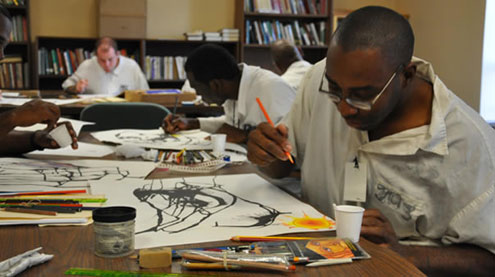 Behind the locked doors, fences and walls of Alabama’s prisons, students from both Auburn University and the University of Alabama are working with inmates to create art.
Behind the locked doors, fences and walls of Alabama’s prisons, students from both Auburn University and the University of Alabama are working with inmates to create art.
The Alabama Prison Arts and Education Project, operated out of Auburn University, offers select prisons classes in visual arts, poetry, creative writing, literature, history and other courses in the arts and humanities. Often, the classes are taught by graduate students in their respective program.
Since 2002, the Project has grown from a single poet teaching in a single prison to a group of teachers from multiple universities teaching 120 to 150 combined students across six different facilities.
Kyes Stevens, the founder and director of the project, said the project is important because of the educational opportunities it provides to people who might not have had positive experiences with education in the past.
“The fundamental premise of the program is that education is needed by everybody, and this is a population in our state that would benefit,” Stevens said. “We don’t refer to our students as inmates. We try to refer to them as students. Most of them don’t have good experiences in their educational past, so referring to them as a student instead of an inmate is really meant to make our interaction with them positive. It’s important to make that distinction.”
For two and a half hours per week for 12- to 14-weeks, well-behaved inmates sit down in a classroom with a teacher and focus on creativity. Students’ work is featured in an annual anthology and a traveling art show called Art on the Inside, featuring drawings, photographs and occasionally poetry produced by participants in the project.
The prisoners aren’t the only group benefitting from the project. Stevens said the project is not only good for inmates, but for the teachers themselves.
“The program first began with me teaching poetry at Tutwiler Prison for Women,” Stevens said. “When I was there, I fell in love with teaching there. The students there were astonishing, and it was by far the best experience I ever had.”
James Maynard, a UA graduate, described his experience with the project as one of the most valuable he’s had at the University.
“The whole thing is a really great experience, especially for the teacher,” Maynard said. “There’s a higher level of engagement, simply because it’s something out of the ordinary for them. It’s been a positive experience all around for me and, I hope, for them.”
Though it is still relatively small, the project has grown well over the past decade. Stevens sees its continued existence as validation for its success.
“It’s successful because we still exist,” Stevens said. “The Department of Corrections finds a lot of value for our program and looks forward to working with us.”
However, its size still limits what the project can do.
“We’re not a huge organization, so we are in some ways limited in what we are able to do at this point,” Stevens said.
But there are still ways for students to help the project.
“We try to get quality reading material into the general libraries at Auburn,” Stevens said. “We get used books and even, in some cases, new books.”
Robin Behn, a professor in the creative writing program at the University of Alabama and one of the coordinators of the project, said although undergraduate students are unable to actually go into the prisons to teach classes, there are still ways to help.
“Whether it’s your student group, your dorm, your sorority, whatever, book drives would be a great way to help,” Behn said.
To find more information about the Alabama Prison Arts and Education Project and how you can get involved or donate books, go to www.cla.auburn.edu/apaep.









